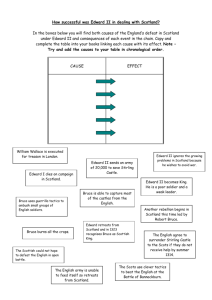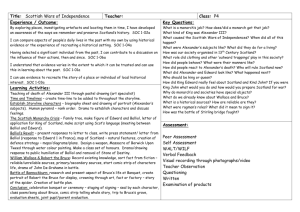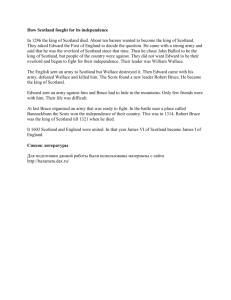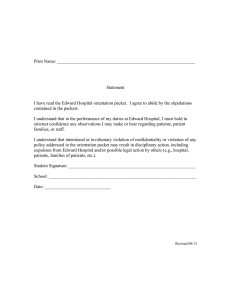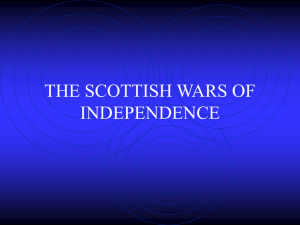Events
advertisement
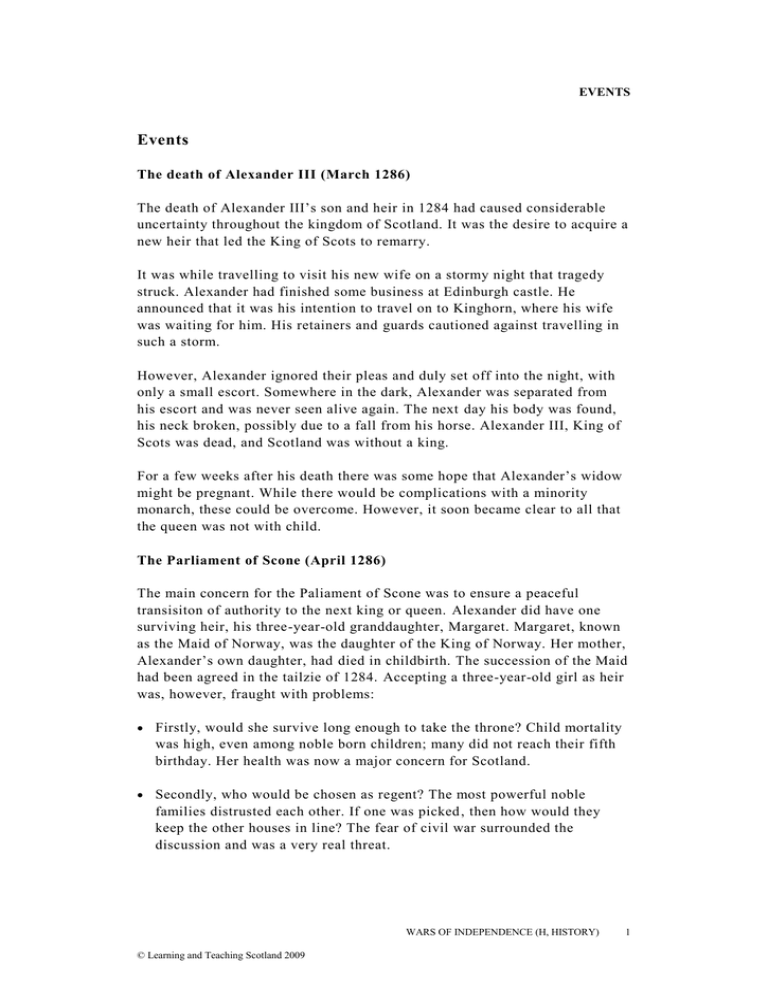
EVENTS Events The death of Alexander III (March 1286) The death of Alexander III’s son and heir in 1284 had caused considerable uncertainty throughout the kingdom of Scotland. It was the desire to acquire a new heir that led the King of Scots to remarry. It was while travelling to visit his new wife on a stormy night that tragedy struck. Alexander had finished some business at Edinburgh castle. He announced that it was his intention to travel on to Kinghorn, where his wife was waiting for him. His retainers and guards cautioned against travelling in such a storm. However, Alexander ignored their pleas and duly set off into the night, with only a small escort. Somewhere in the dark, Alexander was separated from his escort and was never seen alive again. The next day his body was found, his neck broken, possibly due to a fall from his horse. Alexander III, King of Scots was dead, and Scotland was without a king. For a few weeks after his death there was some hope that Alexander’s widow might be pregnant. While there would be complications with a minority monarch, these could be overcome. However, it soon became clear to all that the queen was not with child. The Parliament of Scone (April 1286) The main concern for the Paliament of Scone was to ensure a peaceful transisiton of authority to the next king or queen. Alexander did have one surviving heir, his three-year-old granddaughter, Margaret. Margaret, known as the Maid of Norway, was the daughter of the King of Norway. Her mother, Alexander’s own daughter, had died in childbirth. The succession of the Maid had been agreed in the tailzie of 1284. Accepting a three-year-old girl as heir was, however, fraught with problems: Firstly, would she survive long enough to take the throne? Child mortality was high, even among noble born children; many did not reach their fifth birthday. Her health was now a major concern for Scotland. Secondly, who would be chosen as regent? The most powerful noble families distrusted each other. If one was picked , then how would they keep the other houses in line? The fear of civil war surrounded the discussion and was a very real threat. WARS OF INDEPENDENCE (H, HISTORY) © Learning and Teaching Scotland 2009 1 EVENTS Finally, who would she be married to? Surely a girl, even when grown up, would be unable to rule the country by herself. It was necessary for a suitable husband to take over the responsibilities. However, a Scottish husband would almost certainly have to come from one of the competing noble families. If one was chosen and not the other that in itself might lead to civil war. Equally problematic would be a foreign husband. Who could they trust to maintain the rights and responsibilities of the kingdom? Despite these problems, the nobles gathered at a hastily called parliament at Scone in April 1286. The Scots nobles agreed to work together for the good of the kingdom, rather than for their individual benefit or glory. Two earls, two barons and two bishops were to rule Scotland until Margaret or her husband was able to take over. This was a remarkable show of maturity for the kingdom of Scots and its nobility. A minority ruler was not, in itself, a new thing, given that Alexander II and Alexander III had both been minorities; but they were male and did not live in Norway. The six elected men were given the title Guardians of Scotland, and set out looking for a suitable husband for Margaret. Eventually they agreed to negotiate with the English to arrange a marriage between Margaret and young Prince Edward, the son of Edward I. There was a fear that the guardians would be sidelined by Edward I and Eric, the King of Norway. Eric had been keen to see his daughter installed as queen of Scots, and had sent envoys to Edward I hoping to force the issue. The Treaty of Salisbury (1289) The representatives of both the Guardians of Scotland and the King of England had to negotiate with Margaret’s father as to if and when he would allow her to travel. Further, Edward I was determined that he would not hand his son over in marriage unless Margaret was free of any previous marriage contracts and Scotland was a safe place for them to rule. Edward went further in the treaty, demanding that Margaret be handed over to him, to be raised in the English court, until Scotland was a safe place for her to return to. At the time this was not seen as such an unusual stipulation to make. Different historians have their own opinions as to why Edward demanded this. Perhaps he had already begun to contemplate ways in which he could extend his authority over the kingdom of the Scots. 2 WARS OF INDEPENDENCE (H, HISTORY) © Learning and Teaching Scotland 2009 EVENTS The Treaty of Birgham In July 1290 the Scottish guardians sought concessions from the English upon the marriage. The document is very detailed and shows the safeguards that were put in place to preserve Scotland’s independence. Put simply, the treaty promised the following: Edward I would respect the borders between England and Scotland, and each country would remain separate. Edward agreed that no parliament governing Scotland would be held in England. Scottish laws, customs, rights and freedoms would be preserved. The Scottish church would remain free from interference from the English church. It is because Edward agreed to these demands that many historians do not believe he had any serious desire to pursue his claims of overlordship of Scotland at this time. However, other historians point out that at the same time as agreeing the treaty, Edward also incorporated the Isle of Man into his territory and he insisted the Bishop of Durham help to run Scotland in the name of Margaret. Death of Margaret In September 1290, tragedy again befell Scotland. Marg aret died on her way from Norway to Orkney. The exact cause of her death is not known, although it is likely that she caught pneumonia on the sea voyage and failed to recover. Once again the threat of civil war materialised as Bruce was rumoured to be gathering troops. Fearful of the ambitions of Bruce, Bishop Fraser of St Andrews, one of the six guardians, wrote to Edward I, begging him to intercede. Edward agreed to decide between the 13 claimants for the vacant Scottish crown. For the most part the guardians were happy with this: both Balliol and Bruce believed they had the best argument, and that Edward would favour them. The others knew Edward’s reputation as an expert in the law. Few at this stage were suspicious of his motives. Norham (1291–92) The Scots nobles and clergy met Edward I at Norham, near the border, in May 1291. At Norham, Edward surprised the guardians by demanding that they accept him as their feudal overlord. This was a condition he demanded before making his judgment on who would be King of Scots. He had ordered an army to assemble, in order to intimidate the Scots and make sure that his judgement was accepted. Edward himself claimed that the army was there to WARS OF INDEPENDENCE (H, HISTORY) © Learning and Teaching Scotland 2009 3 EVENTS keep the peace. The Scots had asked Edward to arbitrate (help); Edward believed he was there to judge the case. However, the Scots replied that only their king could deal with such a request, dodging the issue of overlordship in the immediate term. Overall, Edward was now in the driving seat as the Scots needed his help to c hoose their king. At some point during this period, Robert Bruce orchestrated the appeal of the seven earls, a letter written in the name of the Scottish earls stating their support for Robert Bruce’s claim to the throne. Most historians agree, however, that this letter was probably a piece of Bruce propaganda, and is unlikely to truly represent the views of the Scottish earls. Rather, it is Bruce’s response to the letter from Bishop Fraser to Edward I. Bishop Fraser was a supporter of John Balliol’s claim and the guardianship was dominated by the Comyn family. The Great Cause The task of choosing the new king has come to be known as the Great Cause. Of the 13 claimants (14 if you count Edward himself), three men had the best claim – John Balliol, John of Hastings and Robert Bruce. All three were descendants of the daughters of David, Earl of Huntingdon, a descendant of David I of Scotland. In order to ensure he would be overlord of Scotland, Edward demanded that all claimants accepted this before he woul d pass judgment on them. Again, as Edward viewed himself as judge in the case, his judgement would be binding if he established overlordship first. All agreed, as none wished to be left out of the competition to be king, with Balliol last to accept this demand. Both Bruce and Balliol held lands in England for which they already paid homage to the English king, which they would not have wanted to risk. Similar oaths followed from the Scottish guardians, nobles and clergy. Edward had arranged a blockade of Scotland if it proved necessary, to secure his goal of overlordship. He had also obtained possession of the Scottish castles to award to the successful claimant, and appointed English officials to work alongside the Scots. Each claimant in the Great Cause was allowed the opportunity to present their case. All of the evidence was heard and discussed by 104 auditors, who had to deal with questions of legality. Edward enlisted legal opinion from as far afield as Paris. He wanted to ensure that he set the correct precendent. During these proceedings, there was the question of whether , in the absence of a direct heir, Scotland should instead be divided into three between the leading claimants. Was Scotland a real kingdom which was indivisible? Hastings argued that Scotland was little more than a barony which could be divided. There was also the question of whether seniority of line was to be favoured 4 WARS OF INDEPENDENCE (H, HISTORY) © Learning and Teaching Scotland 2009 EVENTS over nearness of degree of relation. The court declared that seniority of line was favoured just before judgment was reached, and Bruce then switched to support Hastings and argued that Scotland should be divided. Some of the competitors, such as Floris V, Count of Holland, were able to hold up the slow proceedings still further by claiming to be searching for docum ents to prove that David, Earl of Huntingdon had given up the rights of inheritance. Edward’s decision Edward announced his decision on 17 November 1292, after 13 months of arguments and debate. In the end, it was decided that John Balliol had the better legal claim. This decision rested on the law of primogeniture, which had been reasonably well established in Scotland since the reign of David I. This law states that inheritance of title and property should pass to the first born child and their descendants. Balliol was thus chosen to become King John of Scots. Edward’s decision has been seen by some as controversial. Notably, subsequent Scottish kings put forward the idea that Bruce had the better claim, and that Edward chose Balliol only because he thou ght he would be easier to manipulate. This propaganda of the Bruce faction may have some weight as Duncan has recently argued that Bruce’s claim had sway with the court in the later months, but that Edward took no notice. Largely, however, historical opinion recognises that Balliol had the better claim. WARS OF INDEPENDENCE (H, HISTORY) © Learning and Teaching Scotland 2009 5
